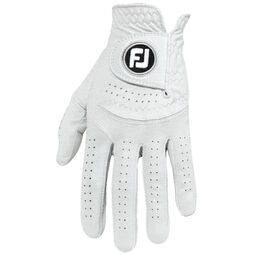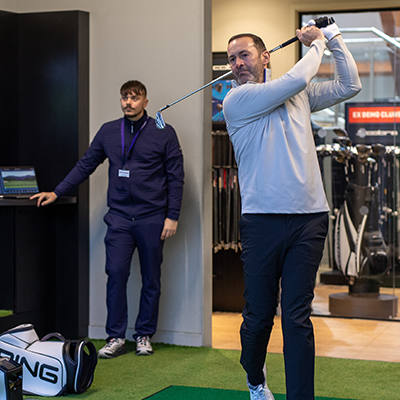We stock a range of optical rangefinders from well known brands such as Garmin and Bushnell. Other products we stock include GPS watches and GPS devices.
Golf Rangefinder
Brand
New In
Sale
Price range
Brand
New In
Sale
Price range
Rangefinders
American Golf provides players with the opportunity to easily improve their game by taking advantage of our immense collection of rangefinders. These essential measuring mechanisms provide golfers with a simpler alternative to measure a yardage rather than using a golf GPS device. The rangefinder depending on the make and model comes shaped like a horizontal or vertical pair of binoculars. Like a pair of binoculars, the golfer would look into the rangefinder’s lens and point it directly at the flag for it to carry out its main purpose of measuring the distance between the pin and where the player is stood. Certain rangefinders provide additional benefits like the slope adjustment feature, however the rangefinder’s main advantage over a device such as a GPS is that it provides more of an accurate measurement of the distance to the pin position on the day of playing. Golf GPS therefore only provides a measured distance to the front, middle, and back of each green, they don’t provide a yardage to where the pin is exactly at the time you are playing the hole. These neat and highly valuable pieces of equipment are available across a variety of different brands and at a series of prices to suit you. Our rangefinder lineup includes devices from some of the top rangefinder and golf GPS brands such as Bushnell, Rife, Shot Scope, Easygreen, Fazer, GolfBuddy and Motocaddy.
Functions
Rangefinders mainly prioritise delivering an impressively precise yardage number between a golfer’s ball and the flag. The rangefinder is able to do this because of the advanced laser signal which bounces back from the flag or area pointed at and then it provides an instantly accurate distance. Unlike the GPS, rangefinders don’t require a course download or require satellite signals to work, they just simply can be pulled in and out of the player's bag and used anywhere at any time. Even though they are mostly used when seeking exact measurements from a player’s ball to the pin, rangefinders are also extremely useful for giving yardage measurements to visible hazards such as to the top of a bunker, hazards or simply a spot in the middle of the fairway. All of which gives a golfer a set of accurate distances which dictate how far and what approach the golfer should take when playing the hole. While this is their initial sole purpose, the majority of the latest rangefinders also include hugely beneficial extra features to provide maximum navigation assistance to a player when on the golf course. The majority of rangefinders include a ‘Pinseeker’ mode which latches onto the flag and vibrates in order to confirm an accurate reading for where the pin is positioned. The option of which measurement metrics the rangefinders operate under is also an available option as golfers can choose to have their rangefinder set to measure in either yards or metres. Devices at the higher end also include a ‘Slope Adjustment’ feature which informs a player how much the change in elevation between the golfer’s ball and the flagstick will affect the yardage a golfer has left in. This is extremely valuable for the club selection process as ultimately it can provide an accurate answer for how much a golfer should club down or up to account for the change of slope. Other models feature certain weather settings which can also provide assistance with giving a yardage number for how much the weather will affect the measured yardage. Aesthetically rangefinders differ between various styles of both vertical and horizontal formats. Some include different batteries in order to guarantee the most suitable battery length for the respective rangefinder device. Ultimately the rangefinder is a handy alternative to using a golf GPS or watch. Rangefinders will therefore act as a prize possession within any golfer’s bag as they are thoroughly needed to precisely measure all yardages on a golf course.
Rangefinders Frequently Asked Questions
What is the best golf rangefinder?
This depends on what you’re looking for, what level of game you’re at, and where you aspire to be. A laser rangefinder is good for golfers who are building their confidence in the game, as these can be more cost-effective for your needs. Laser rangefinders can provide target-lock vibration and slope compensation calculation, adding a little bit more detail to your game at an accessible level.
For regular, confident, and semi-professional players, brands like Bushnell and Shot Scope provide top-of-the-range golf rangefinders. These brands provide powerful and well-respected golf GPS rangefinders with added functionality such as pinseeker technology, advanced magnification, and slope and elements compensation to name but a few.
How accurate are golf rangefinders?
The beauty of golf GPS rangefinders is that they’re incredibly accurate. GPS stands for Global Positioning System which uses satellites to map distances and locations, making GPS rangefinders accurate the +/- 1 yard or just less than 1m. This means they can make long distances, approach shots, and blind spot navigation much easier, helping you to streamline your game.
Are golf rangefinders worth it?
Golf rangefinders are absolutely worth the investment. Even those more accessible, less advanced models offer precise measurements to aid your game. Those designed for more detail-driven usage are obviously favoured by players looking to really optimise their game, and for those who take this seriously then again they are absolutely worth it. Regardless of whether you’re building your confidence or analysing your game in detail, a rangefinder of some calibre will only aid you.
How to use a golf rangefinder scope
An optical rangefinder is typically a monocular - meaning a one-eye device, like a telescope. Activate your rangefinder and hold it to your dominant eye, closing or squinting the other to focus your vision through the lens. The rangefinder’s digital view will then show the distance in yardage to the flag and provide calculations like distance and yardage to the flag. Depending on the make and model you opt for, you could also receive additional metrics. This will help inform your swing speed and which golf club you choose, closing distance between you and the flag and even aiding your escape from blind spots or traps.
Are laser rangefinders legal in golf?
Rangefinders, much like golf watches, used to be strictly banned from most golf competitions and tournaments. Over the last few years, though, they have been steadily introduced to formal competitions and tournaments under fixed regulations for their use.
At the time of writing, you can now use rangefinders or distance-measuring devices to measure yardage to the hole or other in-game locations from your own playing position. Because the rangefinder isn’t technically a ‘smart’ golf device, as it can’t give you shot recommendations, record your progress, or communicate with your coach, it is permitted in most formal competitions. However, it is still worth checking with the organising body or your clubhouse if you can use these distance measuring devices on the golf course.
How Does a Golf Rangefinder Work?
Are you wondering how do a Golf Rangefinder work? A rangefinder is an electronic bit of equipment, directed by a global positioning system (GPS), to tell you, to within a few feet, where you are in the world. In golf, specifically, it gives you distances to greens, hazards and so on, so that you can more accurately plot your way around the course.


































